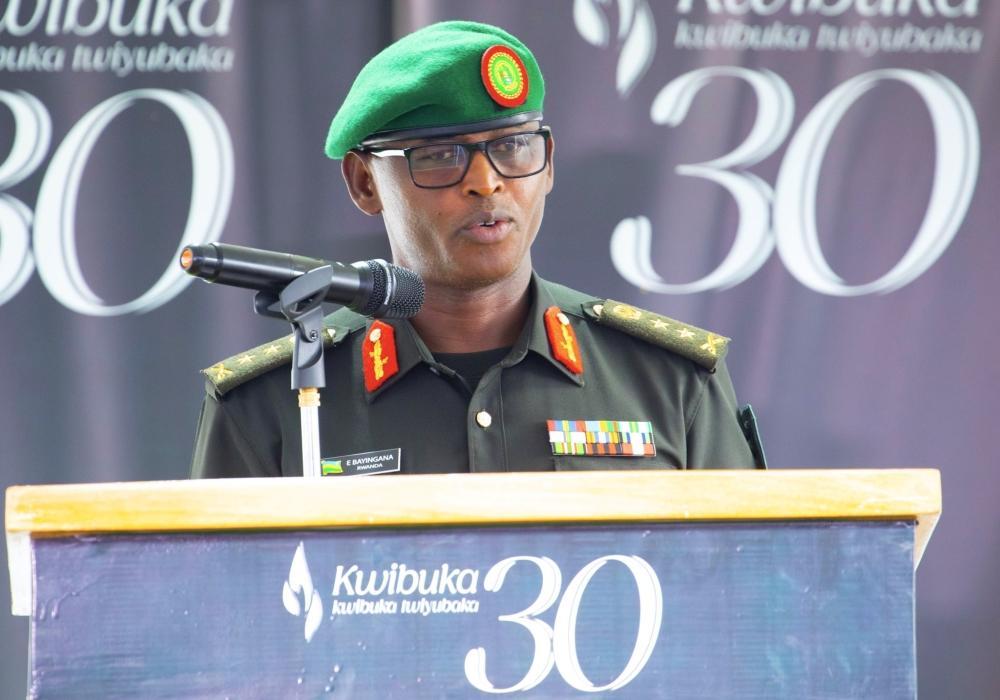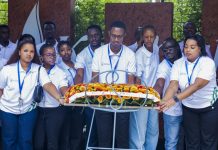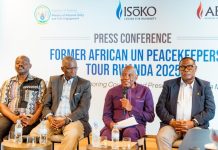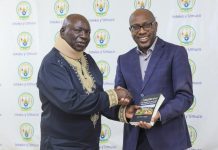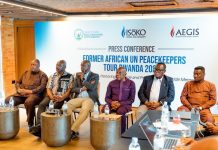Africa-Press – Rwanda. In August 1993, after the signing of peace agreements between the then government of Rwanda and the Rwanda Patriotic Front (RPF), in Arusha, Tanzania, many people breathed a sigh of relief hoping that the persecution against the Tutsi was about to come to end and Rwandans would live in harmony again, according to Maj Gen Emmanuel Bayingana.
But, Bayingana observed, ill-intended political decisions poured cold water on such expectations and, it took crucial resolve and bravery to stop the subsequent Genocide against the Tutsi in April 1994.
He made the observation on May 3 as the Parliament of Rwanda marked the 30th commemoration of the 1994 Genocide against the Tutsi. The commemoration took place at parliamentary buildings which used to host the former national development council (CND) – the country’s legislature until the Genocide.
While delivering a presentation at the event, Bayingana said that on December 28, 1993, some soldiers of RPF’s former military wing, Rwanda Patriotic Army (RPA), left an area then called ‘ku Mulindi wa Byumba’ in Northern Province, and headed to CND. They came along with RPF politicians and dignitaries to prepare for a government of unity with former President Juvenal Habyarimana’s regime, as was agreed in the Arusha accords.
“I remember that towards the end of 1994 and the beginning of 1994, there was a plan to even join the armies on both side – RPF and the Habyarimana regime,” he said.
“That is why the Genocide against the Tutsi we commemorate today, was avoidable. It was possible that it would be prevented, it occurred because of coward decisions that were taken by people who had means in this country. We should remember that,” he said.
Bayingana was one of the RPA soldiers who participated in a military training course in preparation for the merger of the armies.
The training was held at former ESM military school in Kigali which hosts the current College of Science of Technology (former KIST) of the University of Rwanda.
“We studied together, and shared meals with soldiers from Habyarimana’s military – FAR (armed forces of Rwanda).
“While studying or sharing lunch, we used to talk, asking ourselves; ‘what really make us antagonistic?’ Everyone present at [the dinning] table would be saying that politicians did us wrong. I can see we are all Rwandans, what is really the bone of contention among us,” he said, pointing out that they were not aware that a genocidal plot was underway.
But the unexpected happened. That time, Bayingana said, the genocidal regime’s army moved to destroy the parliament building – which still stands today – so that they could exterminate all the 600 RPA soldiers and RPF politicians who were in the building so that they could then commit the Genocide against the Tutsi without a hindrance.
“It was possible that the one [RPF] Inkotanyi battalion, and politicians would be exterminated. The fact that they were not completely killed is something we should be happy about. It is the heroism of Rwandans,” he said, observing that after eliminating them, the genocide perpetrators would have then killed all the Tutsi in Rwanda.
“We should bear that in mind because we would not even have this day to remember our people. People would be completely wiped out,” he said.
While there were UN troops, soldiers of the United Nations Assistance Mission for Rwanda (UNAMIR), in Kigali and especially around the parliamentary buildings, Bayingana said, they did not help but gathered their luggage and left.
The 600 RPA soldiers resisted without artillery
Bayingana said that the RPA 600 soldiers did not come to Kigali with artillery for battle.
They had come with ordinary guns for protecting the security of dignitaries.
That the time, they were surrounded and attacked from different fronts.
The nearby presidential guard military barracks which had heavy weaponry, near the current Kigali Convention Centre, complicated matters for the RPA.
The genocidal regime’s army also had well-armed troops in Kanombe barracks in Kicukiro District, and Kami barracks in Kinyinya Sector, among others.
“All of them decided to meet here [at parliamentary premises] and destroy the people who were here,” Bayingana said.
There was also Camp Kigali (barracks) which had many soldiers, and strategic positions including Mont Kigali from which, he said, originated the bombs that damaged part of the parliamentary building.
That time, Bayingana said, RPA’s commander-in-chief [Paul Kagame] took a crucial decision, telling all soldiers to come to the rescue of the Tutsi who were being killed. Saving the RPF Inkotanyi delegation that was targeted at parliament, and the Tutsi who were being killed, was difficult in that period – the distance between Kigali and RPF Inkotanyi soldiers was long, and it was not a straightforward journey, he said.
They were based along the Rwanda-Uganda border, in areas including Butaro, and Kivuye, in the northern part of Rwanda, and had retreated to permit the smooth implementation of the Arusha accords. But, he said, because of the heroism of Inkotanyi, they soldiered on, and reached Kigali.
After RPF Inkotanyi soldiers received the rescue instructions, they implemented them even though it was not easy. Wherever they passed, there were Habyarimana soldiers.
But on April 10, 1994, at least the first soldiers reached Kigali, from Kivuye. And, on April 11, they entered CND and started helping the battalion that was still fighting, he said, adding that the following day, soldiers arrived in Kigali from Butaro. More of their troops subsequently arrived and they all fought together to defeat the enemy, at the same time rescuing the Tutsi.
Jean Claude Mugenzi, the representative of families of the former parliament workers slain in the Genocide, said that his elder brother, Jean Louis Mugenzi, was among the victims.
Mugenzi commended RPF’s armed wing for its rescue effort.
“If it were not for Inkotanyi that liberated us, we would not be alive today,” he said.
Unity, hope in a desperate country
After the Genocide destroyed Rwandans’ social fabric and unity, and claimed the lives of more than a million people, generally leaving Rwanda with no hope for a future, many people thought the country would no longer be a united nation, Bayingana said, noting that some people were proposing the splitting of the country into two – one part as a country for the Hutu, another for the Tutsi. But, he said, they did not factor in the Twa in their proposals yet they were also part of Rwanda’s social-economic classes – nor the people born from both the Hutu and Tutsi, pointing out that one would wonder what could happen to them.
“But, thanks to a heroic leadership that decided that Rwanda must be rebuilt, and unity be restored,” he said.
For instance, he said, in the national army, starting from 1994, there was a merger of military personnel, with many soldiers that were fighting on the side of Habyarimana joining RPA. He estimated that more than 40,000 troops from the genocidal regime sided with Inkotanyi after the Genocide was stopped.
“This is a major achievement we should be proud of,” he said.
On a political level, he cited the enactment of a constitution in which unity is enshrined as a major fundamental principle for Rwandans.
“This implies that the Genocide will not happen again in the legacy of our country,” he said.
The year 1994 will never be forgotten in Rwanda’s history, he said, because two major events happened: the Genocide against the Tutsi perpetrated by the former regime, claiming more than a million lives; and some Rwandans resolved to fight against genocidaires and defeated them.
“If that did not happen, we would not be here. This is something we should remember as it shows that there are still heroes among Rwandans. And it offers us hope that Rwanda’s future is brighter,” Bayingana said.
For More News And Analysis About Rwanda Follow Africa-Press

